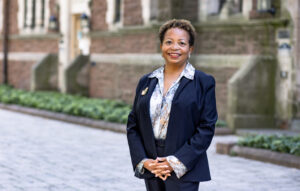After more than a decade at the helm of Trinity College, President Joanne Berger-Sweeney will retire at the end of the academic year, leaving an imprint best viewed in the context of the times.
Two historic moments mark the tenure of the 22nd president of this prestigious liberal arts institution—one unplanned and the other 200 years in the making.

Trinity both charted a path through a global pandemic and celebrated its bicentennial under Berger-Sweeney, whose very appointment as the first woman and first Black president of the College was historic.
“Trinity College is an institution that honors its traditions and embraces its future, and with the selection of Joanne Berger-Sweeney, we have found the right leader to renew our commitment to the value and delivery of an excellent liberal arts education,” said Paul E. Raether ’68, chair of the Trinity Board of Trustees, announcing her appointment in 2014.
No one could predict the emergence of a pandemic half-way through the president’s term. In 2020, as governments and scientists scrambled to respond, Berger-Sweeney also faced new territory in campus policies and procedures.
On-campus classes, research, athletics, and other activities were recalibrated to remote formats and a Commencement ceremony was delayed. The following fall, the campus held classes under the new rubric and, by the end of the spring semester, COVID vaccines had been developed.
“Commencement 2022, when we brought back the class of 2020 for an in-person graduation was a point of pride,” said Berger-Sweeney. “The maturity of the students and their post-graduation success, combined with sheer joy and gratitude, were palpable.”
More recently, the president marked Trinity’s Bicentennial with a yearlong celebration that attracted 11,000 attendees to campus and supported increased opportunities for Hartford students.
From the moment the Bicentennial year launched in the spring of 2023, the occasion provided opportunities for the community to take part in the revelry through a range of events from concerts and performances, to days of reflection and panel discussions. Capping the milestone, Trinity raised $625,000 to establish the Bicentennial Hartford Scholarship.
“The histories of Trinity and Hartford have been intertwined since the very beginning, when the Connecticut General Assembly voted to create the second oldest college in the state. We are proud about what this scholarship will do for both the students of Hartford and for the future of Trinity College,” Berger-Sweeney said at the Bicentennial Gala.
In total, Berger-Sweeney has overseen an increase by 50 percent in financial aid for undergraduate students, enriching the socioeconomic, racial, and international diversity of the student body.
Under Berger-Sweeney’s leadership, Trinity created its Center for Hartford Engagement and Research (CHER) to strengthen academic and co-curricular partnerships between Hartford’s diverse communities and the College’s students, staff, and faculty. Some of Trinity’s ongoing partnerships in Hartford include the Southside Institutes Neighborhood Alliance (SINA) with Connecticut Children’s and Hartford Hospital; and Trinfo, a neighborhood community space, cyber café, and garden that also hosts a successful Volunteer Income Tax Assistance (VITA) program.
In recognition of its work engaging with the Hartford community, Trinity College was awarded Campus Compact’s Richard Guarasci Award for Institutional Transformation. Two-thirds of Trinity students participate in at least one community-engaged course during their time at the College. “Our 2016 revised mission statement articulates Trinity’s role as ‘the preeminent liberal arts college in an urban setting,’ and emphasizes the opportunities that our location offers to engage students in deeper learning that fosters local and global citizenship,” said Berger-Sweeney.
The College’s economic impact also strengthens the health of the city and state. Through both direct and induced spending, Trinity’s impact amounts to $340M annually, according to economist Mark Gius.
In downtown Hartford, Trinity expanded its footprint with the Trinity College Innovation Hub, a 13,000 square-foot purpose-built education, training, networking, and event facility overlooking Constitution Plaza. It houses programming for Trinity’s partnership with Infosys; the Liberal Arts Action Lab, Trinity’s community impact initiative in partnership with Capital Community College; and new innovation and entrepreneurship programming for students in Trinity’s Entrepreneurship Center.
The campus at 300 Summit Street experienced several changes during the past decade. The historic Trinity Chapel and Long Walk were restored; Mather dining room, renovated; Ferris Athletic Center, expanded; football, softball, field hockey, and soccer fields, renovated. The campus also earned a spot on the National Registry of Historic Places, the international list of arboretums, and on the list of “64 Most Beautiful Campuses in America” by Architectural Digest.
Berger-Sweeney also opened the Crescent Street Center for the Arts and Neuroscience (CCAN) and Gruss Music Center. CCAN, a 11,000-square-foot building, embodies the liberal arts by bridging the fields of neuroscience and the arts and incorporating gathering spaces to encourage collaboration and creativity across multiple disciplines. Gruss Music Center was updated to feature a music hall, electronic music lab, a state-of-the-art recording room, and practice rooms.
Additional milestone moments during Berger-Sweeney’s tenure include the naming of the Borges Admissions Center, the “All In” comprehensive campaign, and the 50th anniversary of co-education.
In athletics, where accomplishments are often marked by trips to championships, the awards have piled up. At the same time, Berger-Sweeney served on the National Collegiate Athletic Association Division III Presidents Council.
During this period, Trinity hired the College’s first sustainability coordinator and adopted its first sustainability plan. Berger-Sweeney also hired the first vice president of Diversity Equity and Inclusion, and the College adopted an Action Plan for Racial Justice. Under her, wellness was incorporated into the expanded, Trinity Plus curriculum.
Even after Berger-Sweeney departs Trinity, one of her efforts will provide a regular reminder of her legacy.
The President’s Medal for Science and Innovation, which she initiated, is a nod to her own experience attending a liberal arts institution and pursuing a successful career in neuroscience.
“As a place for problem solvers and innovators, Trinity has a commitment to the sciences that has only grown over time in recognition of the value the sciences provide toward our understanding of an ever-changing world,” she said.
